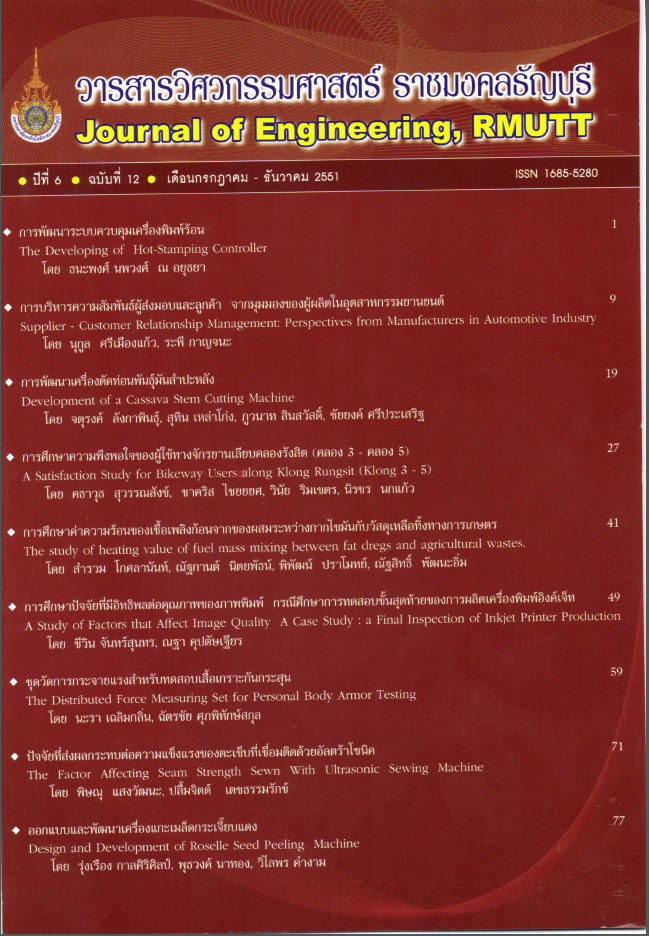Supplier-customer relationship management : perspectives from manufacturers in automotive industry
Main Article Content
Abstract
The purpose of this study is to priorities important criteria in the supplier-customer relationshipmanagement from the viewpoint of manufacturers in the automotive industy. The questionnaire is developedfor collecting data in four main criteria; objectives, supporting factors, obstacles and activities whichsuppliers and customers participated in manufacturer's operations. From statically analysis of 206 returns,the study shows that the main objective to make a relationship with suppliers and customers is to increaseprofit while the most important supporting factor and obstacle to manage the relationship is trust andmisunderstanding in concept, respectively. The most important activities that manufacturer allow the supplierand customer to participate in its operation is data interchanging between organizations. Beside this, thestudy also indicates that the manufacturer ranked the importance of managing relationship with customershigher than managing relationship with suppliers. Even though this study focused on the specific group;automotive indusfiry, at least this would bring a benefit for manufacturers in automotive industry and othersin building and managing relationship with its supplier and customers effectively.
Article Details
The manuscript, information, content, picture and so forth which were published on Frontiers in engineering innovation research has been a copyright of this journal only. There is not allow anyone or any organize to duplicate all content or some document for unethical publication.
References
[2] ชื่นจิตต์ แข้งเจนกิจ, 2544. การบริหารลูกค้าสัมพันธ์. บริษัท ทิปปิ้ง พอยท์ จำกัดกรุงเทพมหานคร.
[3] ปรารถนา ปุณณกิติเกษม, 2552. การศึกษาลำดับความสำคัญของตัวแปรที่ส่งผลต่อการประยุกต์ใช้กลยุทธ์โถจิสติกส์แบบย้อกลับ.วิศวสารลาดกระบัง. 26 (3):55-60
[4] ดวงพรรณ กริชชาญชัย ศฤงคารินทร์,2549.โซ่อุปทานและโลจิสติกส์: ทฤษฎี-งานวิจัยกรณีศึกษา. บริษัท ไอทีแอล เทรด มีเดีย จำกัด, กรุงเทพมหานคร.
[5] รุธิร์ พนมยงค์, ศิริวรรณ ไชยสูรยกานต์, ไพฑูรย์วราเคชสถิตวงศ์และสุวัฒนา จารุมิลินท.2550. การจัดหาและการบริหารความสัมพันธ์กับผู้ส่งมอบในโซ่อุปทาน.บริษัท ไอทีแอลเทรด มีเดีย จำกัด , กรุงเทพมหานคร.(สำนักงานเศรษฐกิจอุตสาหกรรม. 2540. บทความเศรษฐกิจอุตสาหกรรม.[ออนไลน์]:http://www.oie.go.th/index.asp. (6เมษายน2552)
[7] Corsten,D., and Felde,J. 2005. Exploring the performance effects of key-supplier collaboration An empirical investigation into Swiss buyer - supplier relationship.International Journal of Physical Distribution. 35 (6): 445 - 461
[8] Duffy,R., and Fearne, A. 2004 . The impact of supply chain partnerships on supplier performance. The International Journal of Logistics Management. 15(1):57-72.
[9] Furlan,A., Romano,P. and Camuffo,A. 2006.Customer-supplier integration forms in the air-conditioning industry. Journal of Manufacturing Technology Managemen.17 (5): 633 - 655.
[10] Groves,G. and Valsamakis, V. 1998. Supplier- Customer Relationships and Company Performance. The International Journal of Logistics Management. 9(2): 51-64.
[11] Gloria,M, and Talavara, V. 2008. Supply chain collaboration in the Philippines. Journal of International Business Research.7(2):65-83.
[12] Kayis,B. and Kara,S. 2004. The supplier and customer contribution to manufacturing flexibility Australian manufacturing industry's perspective. Journal of Manufacturing Technology Management. 16(7): 733-752.
[13] Lambert,D.M. and Pohlen,T.L. 2001. Supply Chain Metrice. The International Journal"of Logistics Management. 12(1): 1-15.
[14] Lamber,D.M., Cooper, M.C. and Pagh,J.D.1998. Supply chain management : Implementation issue and research opportunities . The International Journal of Logistics Management.9 :1-19.
[15] Li,Q., Su,Y. and Pei,Y. 2007. A Review and Analysis of Researches on Supply Chain Partnership. Proceedings of the IEEE International Conference on Automation and Logistics.7: 1846-1851.
[16] Mcintosh,G. and Fitzgeraid, E. 2000 .A survey of supply chain collaboration and management in the UK construction industry . European Journal of Purchasing and Supply Management .6: 159-168.
[17] Myhr, N.S., and Spekman,R. E. 2005.Collaborative supply-chain partnerships built upon trust and clectronically mediated exchange . Journal of Business & Industrial Marketing.3:179-186.
[18] Narasimhan, R, and Arlbjorn, J.S. 2008 .Information sharing buyer – supplier relationships and firm performance . The International Journal of Logistics Management. 1: 24-29.
[19] Prajogo,D.I,, Power,D.J., and Sohal,A.S. 2004.The role of trading partner relationships in determining innovation performance: an empirical examination . European Journal of Innovation Management. 7(3): 178-186.
[20] Srivastara,S.K. 2007. Green Supply chain management: A State of The Art Literatuer Review . The International Journal of Management Review.9:53-80
[21] Simatupang,T.M. and Sridharan,R. 2005.An integrative framework for supply chain collaboration . The International Journal of Logistics Management 35(1): 257-274
[22] Sahay, B.S. 2003. Supply chain collaboration:the key to value creation. The International Journal Logistics Management. 52(2):76-83
[23] Spensk. 2009. A Study of Supply Chain Management Practices in Finland and United . Operations And Supply Chain Management. 2 (2): 79-92.
[24] Vossb,C., and Burce,S.B. 2005. The impact of supply chain relationship quality on quality Performance . International Journal of Production Economics. 96 : 339-354
[25] Vereecke,A, and Muylle,S. 2006. Performance improvement through supply chain collaboration in Europe . International Journal of Operations & Production Management. 26(11):1176-119


